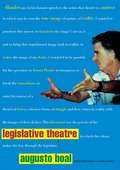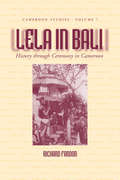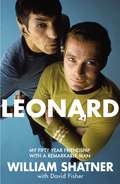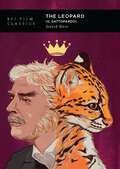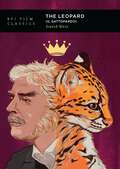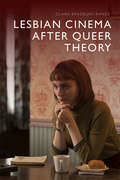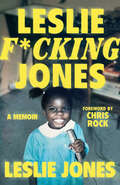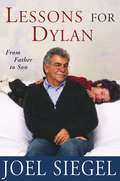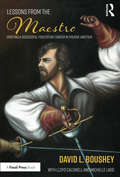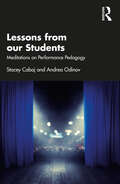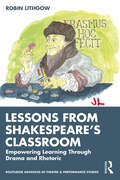- Table View
- List View
Legislative Theatre: Using Performance to Make Politics
by Augusto BoalAugusto Boal's reputation is now moving beyond the realms of theatre and drama therapy, bringing him to the attention of a wider public. Legislative Theatre is the latest and most remarkable stage in his work. 'Legislative Theatre' is an attempt to use Boal's method of 'Forum Theatre' within a political system to create a truer form of democracy. It is an extraordinary experiment in the potential of theatre to affect social change. At the heart of his method of Forum Theatre is the dual meaning of the verb 'to act': to perform and to take action. Forum Theatre invites members of the audience to take the stage and decide the outcome, becoming an integral part of the performance. As a politician in his native Rio de Janeiro, Boal used Forum Theatre to motivate the local populace in generating relevant legislation. In Legislative Theatre Boal creates new, theatrical, and truly revolutionary ways of involving everyone in the democratic process. This book includes: * a full explanation of the genesis and principles of Legislative Theatre * a description of the process in operation in Rio * Boal's essays, speeches and lectures on popular theatre, Paolo Freire, cultural activism, the point of playwrighting, and much else besides.
Legitimating Television: Media Convergence and Cultural Status
by Michael Z Newman Elana LevineLegitimating Television: Media Convergence and Cultural Status explores how and why television is gaining a new level of cultural respectability in the 21st century. Once looked down upon as a "plug-in drug" offering little redeeming social or artistic value, television is now said to be in a creative renaissance, with critics hailing the rise of Quality series such as Mad Men and 30 Rock. Likewise, DVDs and DVRs, web video, HDTV, and mobile devices have shifted the longstanding conception of television as a household appliance toward a new understanding of TV as a sophisticated, high-tech gadget. Newman and Levine argue that television’s growing prestige emerges alongside the convergence of media at technological, industrial, and experiential levels. Television is permitted to rise in respectability once it is connected to more highly valued media and audiences. Legitimation works by denigrating "ordinary" television associated with the past, distancing the television of the present from the feminized and mass audiences assumed to be inherent to the "old" TV. It is no coincidence that the most validated programming and technologies of the convergence era are associated with a more privileged viewership. The legitimation of television articulates the medium with the masculine over the feminine, the elite over the mass, reinforcing cultural hierarchies that have long perpetuated inequalities of gender and class. Legitimating Television urges readers to move beyond the question of taste—whether TV is "good" or "bad"—and to focus instead on the cultural, political, and economic issues at stake in television’s transformation in the digital age.
Legitimating Television: Media Convergence and Cultural Status
by Michael Z Newman Elana LevineLegitimating Television: Media Convergence and Cultural Status explores how and why television is gaining a new level of cultural respectability in the 21st century. Once looked down upon as a "plug-in drug" offering little redeeming social or artistic value, television is now said to be in a creative renaissance, with critics hailing the rise of Quality series such as Mad Men and 30 Rock. Likewise, DVDs and DVRs, web video, HDTV, and mobile devices have shifted the longstanding conception of television as a household appliance toward a new understanding of TV as a sophisticated, high-tech gadget. Newman and Levine argue that television’s growing prestige emerges alongside the convergence of media at technological, industrial, and experiential levels. Television is permitted to rise in respectability once it is connected to more highly valued media and audiences. Legitimation works by denigrating "ordinary" television associated with the past, distancing the television of the present from the feminized and mass audiences assumed to be inherent to the "old" TV. It is no coincidence that the most validated programming and technologies of the convergence era are associated with a more privileged viewership. The legitimation of television articulates the medium with the masculine over the feminine, the elite over the mass, reinforcing cultural hierarchies that have long perpetuated inequalities of gender and class. Legitimating Television urges readers to move beyond the question of taste—whether TV is "good" or "bad"—and to focus instead on the cultural, political, and economic issues at stake in television’s transformation in the digital age.
Lehman Brothers: A Crisis Of Value
by Oonagh McDonaldUsing extensive documentary evidence and interviews with former Lehman employees, Oonagh McDonald reveals the decisions that led to Lehman’s collapse, investigates why the government refused a bail-out and whether the implications of this refusal were fully understood. In clear and accessible language she demonstrates both the short and long term effects of Lehman’s collapse.
Leigh, Myself and I: The Autobiography of Me
by null Leigh Francis'From humble beginnings to the top of the entertainment tree and everything in between! A beautiful book about a beautiful man' Paddy McGuinness 'Leigh is an artistic genius. This is a unique book' Davina McCall 'Funny, honest and utterly creative. This book is a lot like the man himself!' Fearne Cotton One of Britain’s most recognisable television personalities shares a memoir of his life for the first time ever … as himself. ‘You’re doing a book!!!???’ my friend said. ‘Yes,’ I replied. ‘What, is someone writing it for you?’ ‘No. I’m writing it. It’s my book. It’s about me!’ I said. ‘But what about the spelling and the whole dyslexia thing?’ she said. ‘I’m sure the people that publish the book or my agent will check all of that,’ I said. So from the get-go I apologise if there are any typos or grammatical mistakes. There shouldn’t be, as I’m sure the book-making fairy has checked through it all. Big cheers to the book-making fairy! Hurraaahhh! I’ve actually written books before. Seven, if I’m blowing my own trumpet. But never about me, Leigh Francis. Not many people know the real me. They know Keith Lemon, Avid Merrion, The Bear, but this book is all about who I am, out of character, totally honest, just being me. There’s going to be some sad bits, but hopefully there’ll be more happy bits that’ll put a smile on your face a few times. It’s everything I can remember up to the present day. When I was at school they called me Francis, Franny, Eyes (my middle name is Izaak – hence eyes, I guess). Oh, I’ve also been called Ginger Bollox many times too, Ginger Bastard, Fat Ginger Bastard, all the ginger stuff. But I ain’t moaning about that. I am ginger! Ginger and proud. Anyway, let’s start with my first memory, which was being circumcised when I was three. If we’re going to be starting at all.
Lela in Bali: History through Ceremony in Cameroon (Cameroon Studies #7)
by Richard FardonLela in Bali tells the story of an annual festival of eighteenth-century kingdoms in Northern Cameroon that was swept up in the migrations of marauding slave-raiders during the nineteenth century and carried south towards the coast. Lela was transformed first into a mounted durbar, like those of the Muslim states, before evolving in tandem with the German colonial project into a festival of arms. Reinterpreted by missionaries and post-colonial Cameroonians, Lela has become one of the most important of Cameroonian festivals and a crucial marker of identity within the state. Richard Fardon’s recuperation of two hundred years of history is an essential contribution not only to Cameroonian studies but also to the broader understanding of the evolution of African cultures.
Lena Horne: Goddess Reclaimed (Turner Classic Movies)
by Donald BogleFrom Donald Bogle, the award-winning author of Hollywood Black and leading authority on Black cinema history, this is a first-of-its-kind comprehensive and lavish biography of Hollywood&’s first African American movie goddess. Lena Horne&’s life and career are truly remarkable in American film history. She was the first Black performer to become a true star—to receive the kind of glamour treatment at the fabled MGM that the studio had previously given to the likes of Greta Garbo, Jean Harlow, Lana Turner, and Ava Gardner. At the same time, Horne dealt with endless indignities, not the least of which was the fact that her roles in films was often as a musical performer, which allowed her numbers to be easily stripped out of films without affecting the narrative when played to audiences that would find her presence undesirable. At long last, Lena Horne: Goddess Reclaimed gives the star her due. Through a highly informed and insightful narrative based on interviews, press accounts, studio archives, and decades of research, the book sheds new light on the star's compelling life and complicated career: her activism; her accomplishments and heady triumphs in movies, television, and nightclubs as she broke down long-standing barriers for Black individuals—especially Black women—and her solemn, sometimes bitter disappointments, both professional and personal. Illustrated by stunning photos (some published for the first time), this is the ultimate book on the icon.
Lennon: The Man, the Myth, the Music - The Definitive Life
by Tim RileyMusic historian and journalist Tim Riley's biography challenges many popular assumptions about Lennon's life, from his widely misunderstood 'Working Class Hero' origins to his epic romance with Yoko Ono. Riley also explores Lennon in all his contradictions: the misogynist turned peace activist, the moralist who loved to outrage and the 'bigger than Christ' LSD enthusiast who settled down to become a house-husband.A pre-eminent scholar of Beatles music, Riley has consulted some of the most important Beatles scholarship of the past two decades. In a field littered with untrustworthy memoirs, he has culled the most reliable information from hundreds of books, and tracked down even more insightful sources among Lennon's friends, enemies, confidantes, celebrity associates and business contacts. He also writes brilliantly about the music and about Lennon's artistic and creative processes. The Beatles have just enjoyed their most successful sales decade ever, and this book will be a great gift for the Beatles fan in your life or for anyone with an interest in this British music legend.
Leonard: My Fifty-Year Friendship With A Remarkable Man
by William ShatnerLeonard Nimoy and William Shatner first crossed paths as actors on the set of The Man from U.N.C.L.E. Little did they know that their next roles, in a new science-fiction television series called Star Trek, would shape their lives in ways no one could have anticipated. In seventy-nine television episodes and six feature films, they grew to know each other more than most friends could ever imagine.Over the course of half a century, Shatner and Nimoy saw each other through personal and professional highs and lows. In this powerfully emotional book, Shatner tells the story of a man who was his friend for five decades, recounting anecdotes and untold stories of their lives on and off set, as well as gathering stories from others who knew Nimoy well, to present a full picture of a rich life.As much a biography of Nimoy as a story of their friendship, Leonard is a uniquely heartfelt book written by one legendary actor in celebration of another.
The Leopard (BFI Film Classics)
by David WeirLuchino Visconti's The Leopard (Il Gattopardo, 1963) tells the story of an aristocratic Sicilian family adjusting to the realities of political and commercial modernity after the unification Italy during the Risorgimento.The film, starring Claudia Cardinale, Burt Lancaster and Alain Delon, met with success upon its initial release, winning the Palme d'Or at Cannes and having a successful theatrical run in Europe. Despite this, however, it did not do well with English-speaking audiences, and eventually even fell out of favour with Italian audiences, who took issue with the way Risorgimento history was represented. David Weir's study of the film seeks to understand the film's paradoxical place in Italian film history. He argues that Visconti's use of artifice, narrative and history, all aspects that came to be criticised, were in fact, essential to his cinematic art, and can all be understood as strengths of the film. Providing a scene-by-scene analysis of the film, as well as illuminating its relationship to the Lampedusa novel from which it was adapted, Weir suggests that Visconti's film goes beyond mere adaptation, using the form of the novel for cinematic purposes and making The Leopard a cinematic novel in its own right. He goes on to situate the film within Visconti's career, questioning whether the uneven reception of the film reflects the paradox of Visconti's social status as a Marxist aristocrat and his position as an auteur director whose films borrowed heavily from the decadent tradition, while at the same time professing allegiance to the Italian Communist Party.
The Leopard (BFI Film Classics)
by David WeirLuchino Visconti's The Leopard (Il Gattopardo, 1963) tells the story of an aristocratic Sicilian family adjusting to the realities of political and commercial modernity after the unification Italy during the Risorgimento.The film, starring Claudia Cardinale, Burt Lancaster and Alain Delon, met with success upon its initial release, winning the Palme d'Or at Cannes and having a successful theatrical run in Europe. Despite this, however, it did not do well with English-speaking audiences, and eventually even fell out of favour with Italian audiences, who took issue with the way Risorgimento history was represented. David Weir's study of the film seeks to understand the film's paradoxical place in Italian film history. He argues that Visconti's use of artifice, narrative and history, all aspects that came to be criticised, were in fact, essential to his cinematic art, and can all be understood as strengths of the film. Providing a scene-by-scene analysis of the film, as well as illuminating its relationship to the Lampedusa novel from which it was adapted, Weir suggests that Visconti's film goes beyond mere adaptation, using the form of the novel for cinematic purposes and making The Leopard a cinematic novel in its own right. He goes on to situate the film within Visconti's career, questioning whether the uneven reception of the film reflects the paradox of Visconti's social status as a Marxist aristocrat and his position as an auteur director whose films borrowed heavily from the decadent tradition, while at the same time professing allegiance to the Italian Communist Party.
Leos Carax (French Film Directors Series)
by Fergus Daly Garin DowdThe first book in any language to study the films of this enfant terrible of contemporary French cinema, best known for his film Les Amants du Pont Neuf. Examines key ingredients in the worlds of Carax's films – Paris, pop music, 'flânerie' and 'amour fou', 'mannerist' and 'neo-baroque' aesthetics, the Nouvelle Vague and contemporary 'naturalist' cinema – making the book a good primer of contemporary French film and culture. Draws on a variety of intellectual sources, such as the philosophy of Deleuze, film criticism, theory of art, and literary monographs. Argues that the recent history of maverick mannerist and baroque auteurs, from Ruiz & Rivette to Garrel and Techine, and their explorations of the 'powers of the false' are key to Carax's cinema. Examines Carax's contribution to the strand of cinema which is focused on chance and destiny, from Wong Kar-Wai and David Lynch to films such as Serendipity and Sliding doors.
Les Diaboliques: French Film Guide (Ciné-File French Film Guides)
by Susan HaywardLes Diaboliques (The Fiends ) was a top grossing film in 1955. Clouzot shrouded his film in mystery, beseeching his audience not to give away the ending. He also radically changed the original story of Boileau and Narcejeac's novel (Celle qui n'était plus ), heterosexualising the original lesbian plot. His film demonstrates how to imply, rather than show, horror, keeping the spectator in a state of continued suspense, only releasing us in the few final frames. Fifty years later, Les Diaboliques still intrigues perhaps due to its excessive ambiguities and numerous plot twists that make it a film noir to end all films noirs, and not least the great performance of Simone Signoret. In this enjoyable and challenging Ciné-File, Susan Hayward, leading writer on French cinema, sets Les Diaboliques against the political culture of its time and demonstrates the importance of Clouzot as a master of the thriller genre. She gives an illuminating in-depth textual analysis of the film and presents a comparison with its US remake which, juxtaposed with the original film book, highlights the great staying power of Clouzot's version, still a popular film with international audiences half a century after its première.
Les Enfants du Paradis (BFI Film Classics)
by Jill ForbesLes Enfants du paradis, a magnificent picaresque saga of Parisian street life and popular culture, has been called the greatest film ever made. Completed during the Occupation, it nevertheless boasted the largest set ever to have been built in a French studio, a crowd of extras and, under the direction of Marcel Carné, some of the most accomplished technicians and actors available (including Arletty and Jean-Louis Barrault as the central couple doomed to remain apart).Jill Forbes examines how, at a time of crisis, the film reimagined the history of France. Although Les Enfants du paradis is escapist, even fantastic, Forbes finds in it a radical, counter-cultural sensibility concerned with destabilising social hierarchies and prescribed sexual roles and questioning the opposition between life and art. Vibrant, joyous but also touched by melancholy, the film combines the traditions of high culture and popular theatre to remarkable effect.
Les Enfants du Paradis (BFI Film Classics)
by Jill ForbesLes Enfants du paradis, a magnificent picaresque saga of Parisian street life and popular culture, has been called the greatest film ever made. Completed during the Occupation, it nevertheless boasted the largest set ever to have been built in a French studio, a crowd of extras and, under the direction of Marcel Carné, some of the most accomplished technicians and actors available (including Arletty and Jean-Louis Barrault as the central couple doomed to remain apart).Jill Forbes examines how, at a time of crisis, the film reimagined the history of France. Although Les Enfants du paradis is escapist, even fantastic, Forbes finds in it a radical, counter-cultural sensibility concerned with destabilising social hierarchies and prescribed sexual roles and questioning the opposition between life and art. Vibrant, joyous but also touched by melancholy, the film combines the traditions of high culture and popular theatre to remarkable effect.
Lesbian Cinema after Queer Theory
by Clara Bradbury-RanceThe unprecedented increase in lesbian representation over the past two decades has, paradoxically, coincided with queer theory’s radical transformation of the study of sexuality. In Lesbian Cinema after Queer Theory, Clara Bradbury-Rance argues that this contradictory context has yielded new kinds of cinematic language through which to give desire visual form. By offering close readings of key contemporary films such as Blue Is the Warmest Colour, Water Lilies and Carol alongside a broader filmography encompassing over 300 other films released between 1927 and 2018, the book provokes new ways of understanding a changing field of representation. Bradbury-Rance resists charting a narrative of representational progress or shoring up the lesbian’s categorisation in the newly available terms of the visible. Instead, she argues for a feminist framework that can understand lesbianism’s queerness. Drawing on a provocative theoretical and visual corpus, Lesbian Cinema after Queer Theory reveals the conditions of lesbian legibility in the twenty-first century.
Lesbian, Gay, and Transgender Athletes in Latin America (Palgrave Studies in Masculinity, Sport and Exercise)
by Joaquín Piedra Eric AndersonThis edited volume draws upon work from a wide range of established and emerging international scholars to provide an interdisciplinary analysis of sport’s complex relationship with masculinity. With a particular focus on Latin America, it examines the changing relationship between a range of contemporary sport and sexuality and gender expression, as related to lesbian, gay and/or trans athletes. Experts from Spain, Argentina, Brazil, Mexico, and Colombia provide historical, sociological and anthropological perspectives on heteronormativity, masculinity, gender identity, sexual orientation, and the gender binary as they relate to sports clubs, Mexican martial arts, football, softball, sports media, games, and physical education. It will be invaluable to scholars and students in the fields of Gender Studies, Queer Studies, Sports Studies, and Men’s Studies.
Lesbians in Television and Text after the Millennium
by R. BeirneTaking up such issues as mainstreaming, the male gaze, and female masculinity, this book puts forward provocative readings of little explored texts and offers new insights into the contemporary representation of lesbians.
Leslie F*cking Jones: A Memoir
by Leslie Jones"You are Black; you are female," Leslie Jones' father once said. "But if you work harder and you're better than everybody else, they can't f*cking deny you."
Lessons For Dylan: On Life, Love, the Movies, and Me
by Joel SiegelAt the age of fifty-seven, movie critic Joel Siegel both became a father for the first time and learned that he had cancer. In Lessons for Dylan, Siegel shares all the things he wants his son to know-in case he's not around to tell him. It's a story about a life well-lived and about living life well. It's chock-full of earnest advice, hilarious anecdotes, a Yiddish lexicon, and recollections of everyone from Brad Pitt to the Beatles. Siegel lays out the History of the Jewish People in Four Jokes; offers Dylan manly advice on sex ("ask your mother"), culinary arts, the movies; and of course, offers a few lectures ("Be anything you want to be, but, please God, please don't want to be an actor"). Along the way, Joel teaches Dylan, and readers, a little something about growing up at any age. At times heart-wrenching, at times laugh-out-loud funny, Joel Siegel has crafted an indelible and enduring love letter to his son, and a literary gift to us all.
Lessons from The Maestro: Crafting a Successful Fight/Stunt Career in Theatre and Film
by David L. BousheyIn Lessons from The Maestro: Crafting a Successful Fight/Stunt Career in Theatre and Film, famed Hollywood and theatre stuntman, trainer, and fight director David L. Boushey writes about his life, the history of stage and screen combat and stunt work, and how to enter the entertainment industry. Charting his illustrious career that spanned over 45 years, 400 theatre credits, and 45 films, Boushey narrates the events and decisions that lead him to enter the entertainment industry and documents for the first time his founding of multiple national and international associations for fight directors and stuntmen. He provides a roadmap for individuals aspiring to work in the theatre and film industry, providing information on training, auditioning, networking, unions, different paths one might take, and tips on how to be a successful stunt performer in a competitive industry. Part autobiography, part how-to guide to the entertainment business from the foremost authority in stage combat and stunt work, this is an invaluable resource for professional and aspiring fight and intimacy directors and stunt performers in theatre and film.
Lessons from The Maestro: Crafting a Successful Fight/Stunt Career in Theatre and Film
by David L. BousheyIn Lessons from The Maestro: Crafting a Successful Fight/Stunt Career in Theatre and Film, famed Hollywood and theatre stuntman, trainer, and fight director David L. Boushey writes about his life, the history of stage and screen combat and stunt work, and how to enter the entertainment industry. Charting his illustrious career that spanned over 45 years, 400 theatre credits, and 45 films, Boushey narrates the events and decisions that lead him to enter the entertainment industry and documents for the first time his founding of multiple national and international associations for fight directors and stuntmen. He provides a roadmap for individuals aspiring to work in the theatre and film industry, providing information on training, auditioning, networking, unions, different paths one might take, and tips on how to be a successful stunt performer in a competitive industry. Part autobiography, part how-to guide to the entertainment business from the foremost authority in stage combat and stunt work, this is an invaluable resource for professional and aspiring fight and intimacy directors and stunt performers in theatre and film.
Lessons from our Students: Meditations on Performance Pedagogy
by Stacey Cabaj Andrea OdinovLessons from our Students: Meditations on Performance Pedagogy is a collection of thirty short personal case studies about pedagogical issues that arise in theater classrooms and rehearsals. Teaching in the acting and performance classroom is rapidly changing in the early 2020s. In the wake of the global pandemic, online education, massive trauma, and a social justice revolution, educators are seeking wisdom, clarity, and reassurance about their pedagogy. The authors speak to the current moment and the unique challenges of teaching theater by presenting a personal, practical, and authentic expression of vulnerability, humanity, and artistry as teachers. Through thirty personal meditations, the authors pose reflective questions and discussion prompts that evaluate the craft of teaching theater, issues that arise, and ideas about how to respond with vision and integrity. Accompanying exercises invite readers to reflect on their own teaching practices. This book serves as a text for theater teachers and teachers-in-training in search of inspiration, validation, and transformation in drama education and theater pedagogy classes.
Lessons from our Students: Meditations on Performance Pedagogy
by Stacey Cabaj Andrea OdinovLessons from our Students: Meditations on Performance Pedagogy is a collection of thirty short personal case studies about pedagogical issues that arise in theater classrooms and rehearsals. Teaching in the acting and performance classroom is rapidly changing in the early 2020s. In the wake of the global pandemic, online education, massive trauma, and a social justice revolution, educators are seeking wisdom, clarity, and reassurance about their pedagogy. The authors speak to the current moment and the unique challenges of teaching theater by presenting a personal, practical, and authentic expression of vulnerability, humanity, and artistry as teachers. Through thirty personal meditations, the authors pose reflective questions and discussion prompts that evaluate the craft of teaching theater, issues that arise, and ideas about how to respond with vision and integrity. Accompanying exercises invite readers to reflect on their own teaching practices. This book serves as a text for theater teachers and teachers-in-training in search of inspiration, validation, and transformation in drama education and theater pedagogy classes.
Lessons from Shakespeare’s Classroom: Empowering Learning Through Drama and Rhetoric (Routledge Advances in Theatre & Performance Studies)
by Robin LithgowThis volume explores the relationship between the emphasis on performance in Elizabethan humanist education and the flourishing of literary brilliance around the turn of the sixteenth century. This study asks us what lessons we can learn today from Shakespeare’s Latin grammar school. What were the cognitive benefits of an education so deeply rooted in what Demosthenes and Quintilian called "actio"—acting? Because of the vast difference between educational practice then and now, we have not often followed one essential thread: the focus on performance. This study examines the connections relevant to the education offered in schools today. This book will be of great interest to teachers, scholars, and administrators in performing arts and education.
